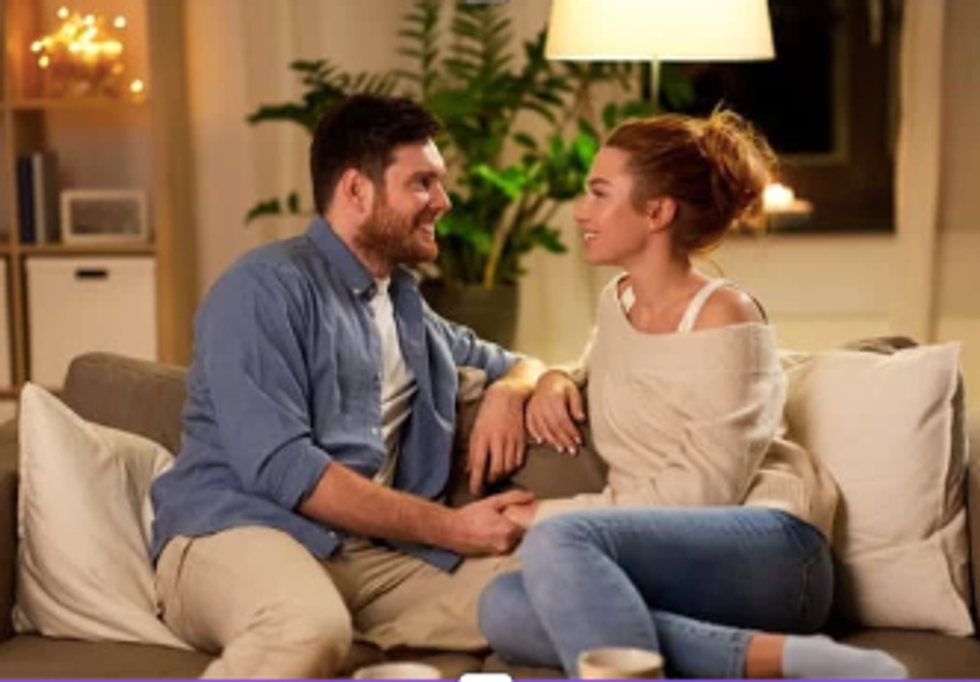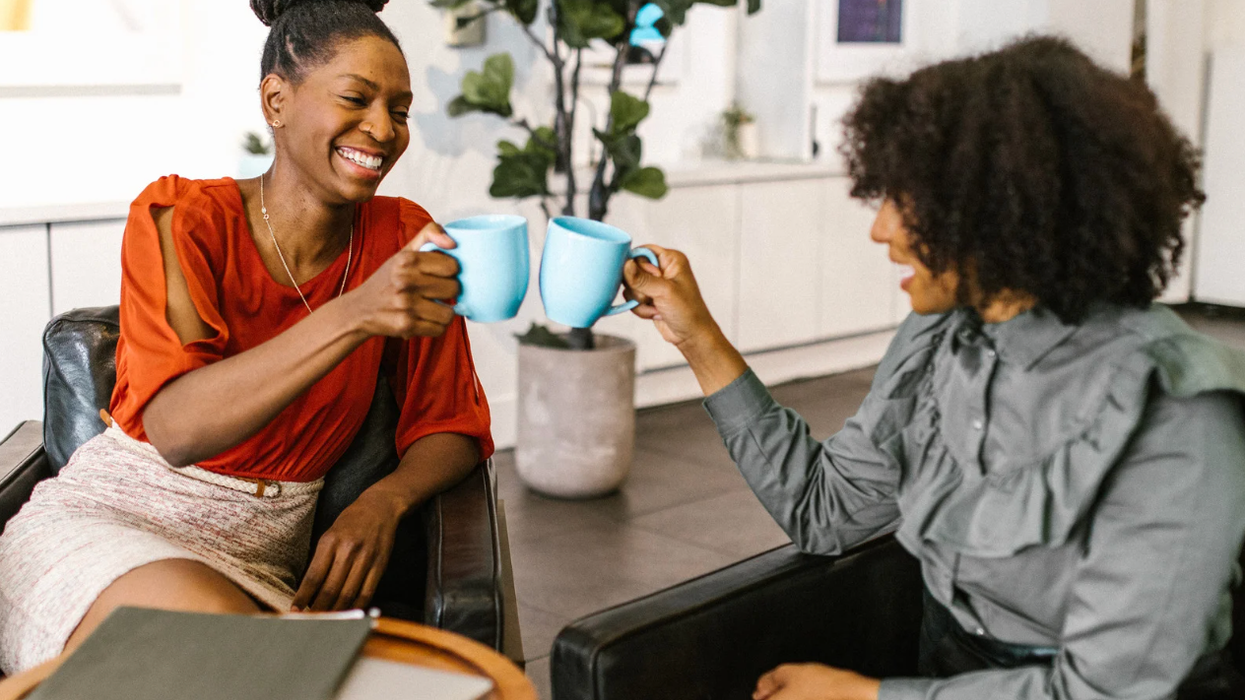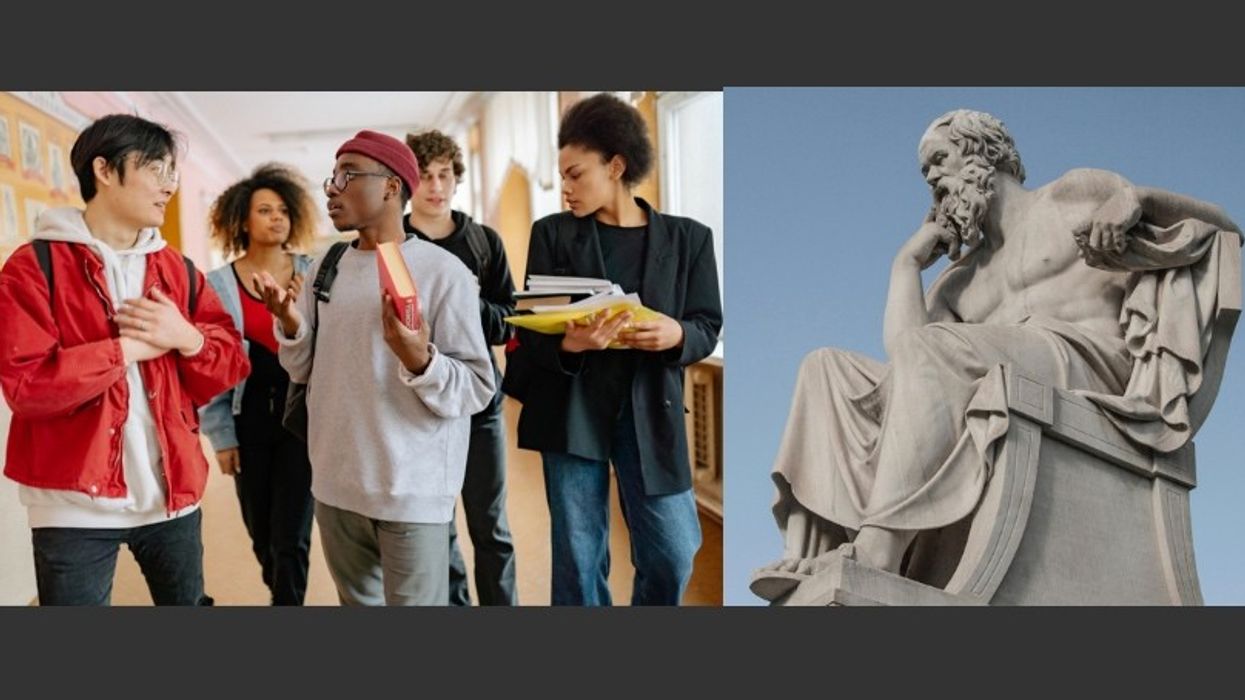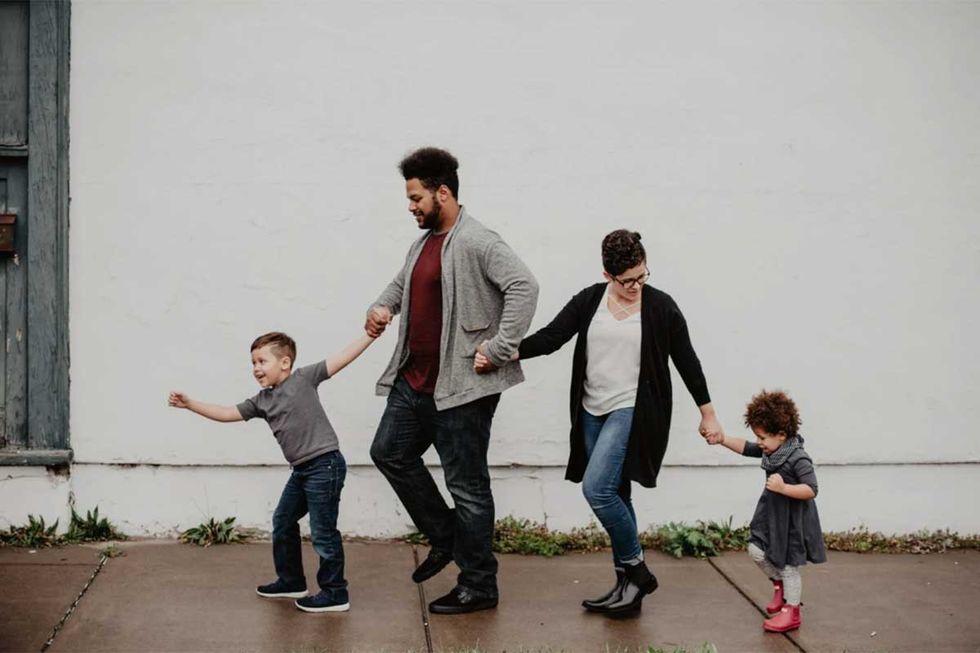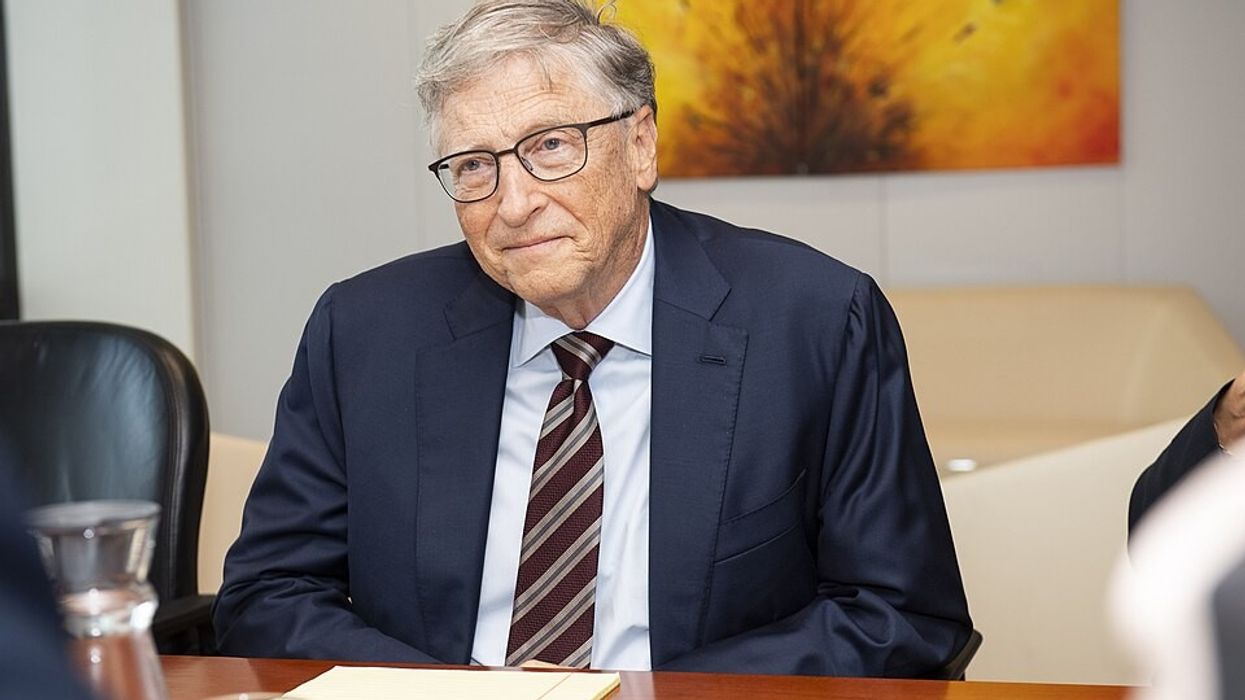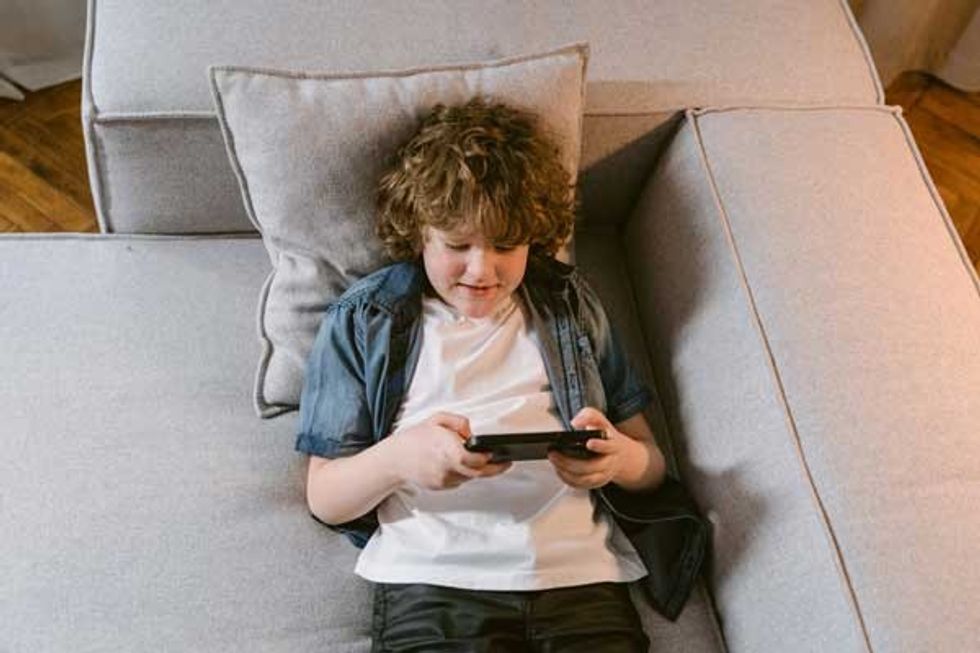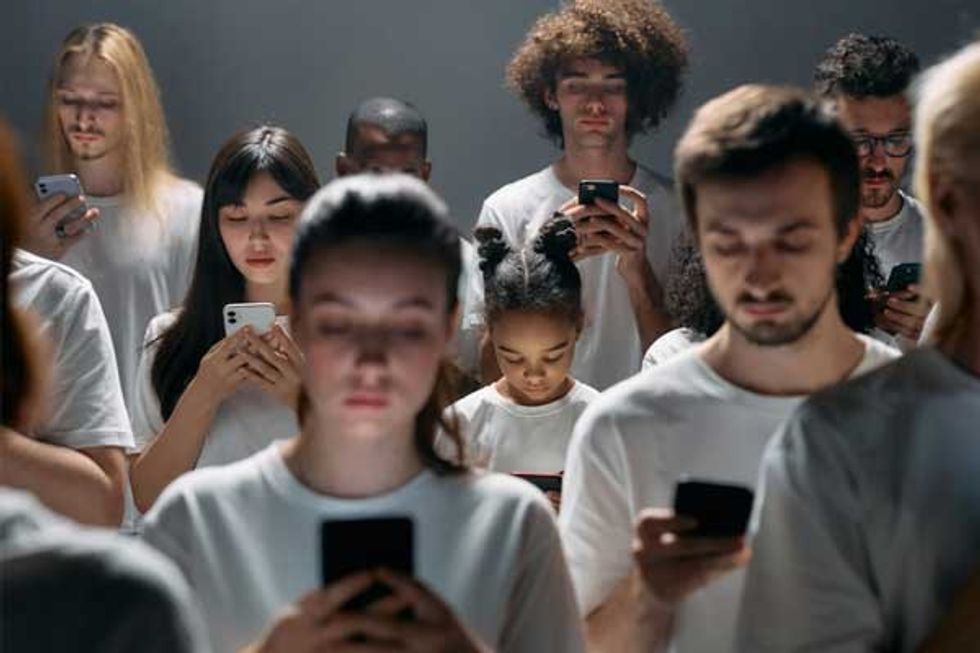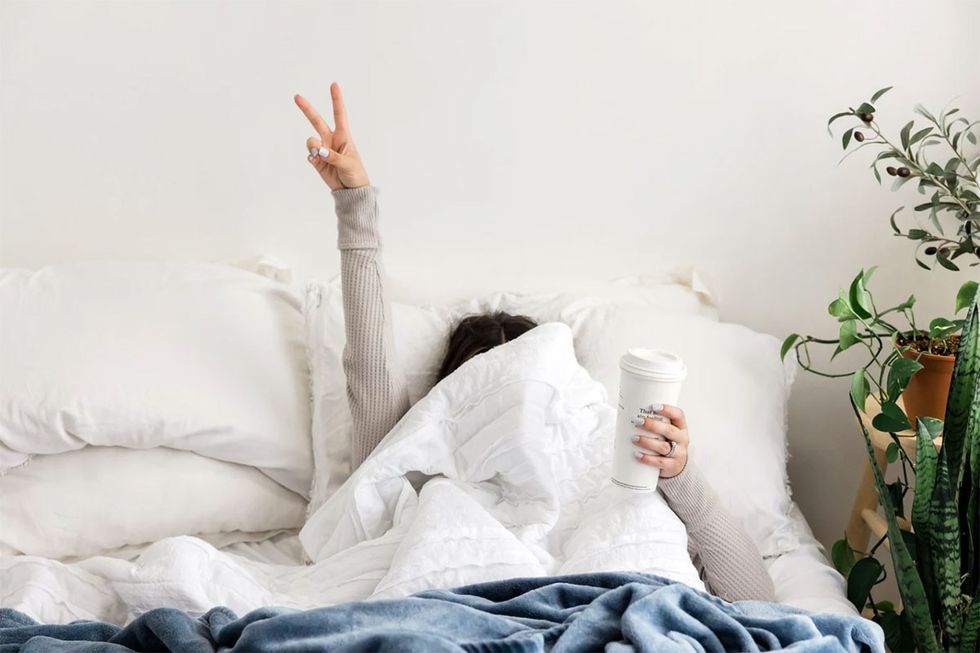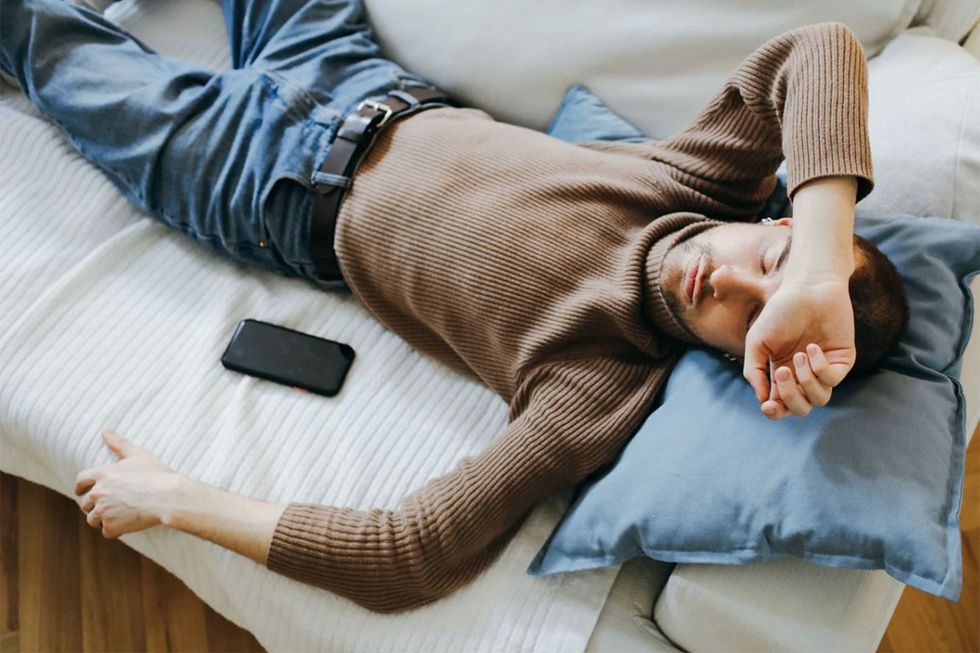|
There are plenty of creative ways to reconnect and have fun without breaking the bank. Canva Psychologist says these 5 free date ideas will bring couples closer together Amy LamareSep 10, 2025 The price of everything is through the roof, leaving many couples struggling to plan date nights. But you don't need money to reconnect with your partner. There are plenty of creative ways to have fun without breaking the bank. In fact, some of these creative date night ideas are just as fun—if not more—than an expensive night out. Before you get to date night, do a quick check in on your relationship to make sure your communication and empathy for each other is on track. Psychologist Mark Travers encourages people to inject novelty into their relationships. Fortunately, fun comes in a variety of price-points, with the most meaningful costing $0. Explore your own city Not everyone has the budget to jet off to a tropical island when they need to reconnect or recharge. But you can explore your city or town. Travers says these "micro-adventures" can be as simple as trying a new coffee shop or wine bar—or even booking a hotel room for a staycation. Check out new-to-you bookstores and restaurants. Lace up your hiking boots and set out on a local trail. Is there a restaurant one or both of you have been dying to try? Make a reservation, get dressed up, and enjoy your night out on the town. The shared adventure gives you and your partner something to hold dear when you are in the muck of daily life and parenting. A lovely night can be had by choosing a recipe, shopping for the ingredients, and cooking it together. Select your wine or beverage of choice and enjoy the evening. A board game or favorite movie can round out the night. Check out local parksPack a picnic and take it to a park. Spread your blanket under a tree and enjoy a beautiful day. Often, parks have free concert series or you could check out a comedy club or open mic night. Explore your city like a tourist.
Maybe you love to knit and your husband likes to play video games. You can knit while he plays. This way you are each enjoying something you love, together. This is called parallel play in psychology circles. "As a result, couples can easily stay bonded without burning themselves out," Travers wrote. "Low-pressure, comfortable companionship supports deeper intimacy just as much as active socialization can." Look back on your traditionsRemember your first date? That thing that went wrong at your wedding that nearly ruined the day? Talk about these things together and find the humor in it. "Rituals play an integral part of relationship satisfaction, quality, and intimacy," Travers pointed out. "Happy couples leverage this by giving the activities that once brought them together a cherished place in their relationship." Talk and dream with your partner the way you did when you were newly in a relationship. How have the dreams you had in the early days of the relationship played out? What new dreams do you have for the future? Keep ReadingShow less Experts agree that one particular question can cause folks to open up. Photo credit: Canva Tired of boring small talk? Experts share how to make people light up immediately. Erik BarnesSep 10, 2025 Whether it’s a first date, a business coffee, or a dinner with a friend of a friend, small talk has the ability to be equal parts nerve-wracking and boring. In situations like these you want to spark up genuine conversation and connection. While there are several icebreaker questions one can use, there is one in particular that most professionals and social experts agree on: “What’s been the highlight of your day?” This question might not seem different from others, but it’s actually more versatile than it seems at face value, especially compared to the common question/greeting, “How are you?” This is because the answer to “How are you?” is usually more vague and could invite negativity or short, abrupt answers. Most of the time, the answer to that question is “Pretty good” or something akin to that. Then that’s it. On the opposite end, "What's been the highlight of your day?" can open up a variety of responses. @q_interviews What’s the highlight of YOUR day today? Tell us in the comments :) . . . I asked Imperial College London students their highlight of the day today. The answers may surprise you because we have some flowers sent to places. Tags: #imperialcollegelondon #universitystudent #universitystudentlife #univ #studentlifeuk #londonuni #londonuniversity #uni #streetinterview #streetinterviews #universitystudents #university #student #london #wholesome The reason why "How are you?" gets poor replies or short ones is because the person answering either is feeling good and aren’t sure whether to expand upon it, or that they’re actually feeling bad and don’t want to share what’s been troubling them to bring the mood down. Asking “How are you?” creates more work for a connection because you’re not only ending up restarting a conversation all over again, but you might possibly restart from a negative headspace if the person you’re interacting with is being reminded of their difficulties. @yayalexisgay when someone asks “how are you?” #comedy #mentalhealth “[Asking “What’s been the highlight of your day?] is my alternative to ‘How are you?,’” says human behavioral researcher and author Vanessa Van Edwards. “Asking someone the best part of their day is a great way to bring up positive vibes, as opposed to just giving you a boring update.” @diaryofaceohub Vanessa Van Edwards explains why not to ask ‘what do you do’ 👀 #networking #business #friend #friends #friendship #podcast #interview #work #working Asking about the highlight of someone’s day (or highlight of their week if you’re in a morning business meeting and the day has just started), allows them to find the one or two things they’ve enjoyed and invites them to expound upon them. If they’re having a good day, they could tell you about a project they’ve completed at work or a personal goal they achieved, giving you insight to their job or whatever else drives them. If they’ve had a rough one, they can reflect positively on small comforts like a great sandwich they had during lunch, a TV show they enjoyed, or something else important to them that brought them comfort if they had an otherwise bad day. Regardless of their answer, you’ll get a deeper understanding of the person as they’ll also provide other conversation jump off points for you to use like, “Oh, tell me more about the project you completed,” or, “Where did you get that sandwich?” etc. It’s a question that isn’t just for networking opportunities or getting to know friends of friends, but can be a great first date question as well. This is because the question invites the answerer to be as open or as guarded as they wish depending on their level of comfort. It also keeps the conversation and the mindset of everyone in a feel-good headspace which can build momentum and closeness as the date goes on. “I like this phrase as a social icebreaker since it opens up for conversing around something that’s positive without it getting too personal, but that still helps people to get closer to each other in a natural way,” says licensed relationship therapist and sexologist Sofi Roos. “It’s a question that’s relatively easy to answer, and the person answering it can choose how many private details they want to share.” This also leads to the person leaving a lasting positive impression on you. By leading with their highlight, you're transporting them back to that positive feeling of accomplishment, contentment, happiness, etc. That will naturally bleed into associating that good feeling with your current conversation partner, making you feel more connected and making you more memorable to them because of it, too. @jayshetty People don’t forget how you made them feel ❤️ So, the next time you’re going out on a date, attending a business brunch, or attempting any other interaction with new people or even old friends, try asking about a highlight of their week. No matter the response, it’ll be easy for them to share and create more interesting tributaries for the conversation to follow. Keep ReadingShow less College students discussing their work, a statue of a philosopher Images via Canva Research on 600,000 college students shows that studying philosophy makes them better thinkers Michael VazquezAug 27, 2025 Philosophy majors rank higher than all other majors on verbal and logical reasoning, according to our new study published in the Journal of the American Philosophical Association. They also tend to display more intellectual virtues such as curiosity and open-mindedness. Philosophers have long claimed that studying philosophy sharpens one’s mind. What sets philosophy apart from other fields is that it is not so much a body of knowledge as an activity – a form of inquiry. Doing philosophy involves trying to answer fundamental questions about humanity and the world we live in and subjecting proposed answers to critical scrutiny: constructing logical arguments, drawing subtle distinctions and following ideas to their ultimate – often surprising – conclusions. It makes sense, then, that studying philosophy might make people better thinkers. But as philosophers ourselves, we wondered whether there is strong evidence for that claim. Students who major in philosophy perform very well on tests such as the Graduate Record Examination and Law School Admission Test. Studies, including our own, have found that people who have studied philosophy are, on average, more reflective and more open-minded than those who haven’t. Yet this doesn’t necessarily show that studying philosophy makes people better thinkers. Philosophy may just attract good thinkers. Our latest study aimed to address that problem by comparing students who majored in philosophy and those who didn’t at the end of their senior year, while adjusting for differences present at the start of their freshman year. For example, we examined students’ performance on the GRE, which they take toward the end of college, while controlling for scores on the SAT, which they take before college. We did the same when analyzing survey data collected by the Higher Education Research Institute at the start and end of college. These surveys asked students to, for example, rate their abilities to engage with new ideas or have their own ideas challenged, and how often they explored topics raised in class on their own or evaluated the reliability of information. All told, we looked at test and survey data from over 600,000 students. Our analysis found that philosophy majors scored higher than students in all other majors on standardized tests of verbal and logical reasoning, as well as on self-reports of good habits of mind, even after accounting for freshman-year differences. This suggests that their intellectual abilities and traits are due, in part, to what they learned in college. Why it mattersPublic trust in higher education has hit record lows in recent years, according to polling by the Lumina Foundation and Gallup. Meanwhile, the rapid advance of generative AI has threatened the perceived value of a traditional college degree, as many previously vaunted white-collar skills are at risk of being automated. Yet now more than ever, students must learn to think clearly and critically. AI promises efficiency, but its algorithms are only as good as the people who steer them and scrutinize their output. The stakes are more than personal. Without citizens who can reason through complex issues and discern good information from bad, democracy and civic life are at risk. What still isn’t knownWhile our results point to real growth in students’ intellectual abilities and dispositions, they do not capture everything philosophers mean by “intellectual virtue.” Intellectual virtue is not just a matter of possessing certain abilities but of using those abilities well: at the right times, for the right reasons, and in the right ways. Our measures do not tell us whether philosophy majors go on to apply their newfound abilities in the service of truth and justice or, conversely, for personal gain and glory. Settling that question would require gathering a different kind of evidence. Michael Vazquez is a Teaching Assistant Professor of Philosophy, University of North Carolina at Chapel Hill Michael Prinzing is a Research and Assessment Scholar, Wake Forest University This article originally appeared in The Conversation Keep ReadingShow less Students in a classroom Image via Canva A college experiment taught Gen Z students how to spot misinformation. It's had stunning results. Sam WineburgAug 26, 2025 Mike Evans knew something had to change. As the lead instructor for American Government 1101 at Georgia State University in 2021, Evans had watched his students over the years show up with fewer facts and more conspiracy theories. Gone were the days when students arrived on campus with dim memories of high school civics. Now they came armed with bold, often misleading beliefs shaped by hours spent each day on TikTok, YouTube and Instagram. One example of misinformation making the rounds back then was an anonymously posted video that more than half of teens in a national survey said provided “strong evidence” of U.S. voter fraud. The video was actually shot in Russia, crucial context that could be gleaned by entering a few choice keywords into a browser. Ignoring the problem of online gullibility felt irresponsible – even negligent. How could the course deliver on its aim of helping students become “effective and responsible participants in American democracy” if it turned a blind eye to digital misinformation? At the same time, a major overhaul of a course that enrolls more than 4,000 students each year – with 15 instructors teaching 42 sections in person, online and in a hybrid format – would create a logistical nightmare. That’s when Evans, a political scientist, came across the Civic Online Reasoning curriculum, developed by the research group I used to lead at Stanford University. The curriculum, which is freely available to anyone, teaches a set of strategies based on how professional fact-checkers evaluate online information. In fall 2021, he reached out with a question: Could aspects of the curriculum be incorporated into American Government 1101 without turning the whole course on its head? My team and I thought so. Teaching informed citizenshipEvans’ challenge was hardly unique to his campus. For Generation Z, born between 1997 and 2012, social media – especially YouTube, TikTok, Instagram and Snapchat – has become their source of information about the world, eclipsing traditional news outlets. In a survey of more than 1,000 young people ages 13 to 18, 8 in 10 said they encounter conspiracy theories in their social media feeds each week, yet only 39% reported receiving instruction in evaluating the claims they saw there. We built our Civic Online Reasoning program to address this gap. When we launched the program in 2018, digital literacy was a catchall that included everything from editing and uploading videos to cyberbullying and sexting. “Checking the credibility of sources” was just one criterion among many buried in a list of desired outcomes. We narrowed the focus of our program to skills essential to being an informed citizen, such as “lateral reading” − that is, using the full context of the internet to judge the quality of a claim, identify the people or organizations behind it and assess their credibility. Rather than fixate solely on the message, we taught students to vet the messenger: What organizations stand behind the claim? Does the source of the claim have a conflict of interest? What are the source’s credentials or expertise? We tested our approach in an experiment in 12th grade classrooms teaching government in Lincoln, Nebraska, public schools. Across six hours of instruction – two hours less than the average teen spends online each day – students nearly doubled in their ability to locate quality information compared to a control group. We thought it wouldn’t be a huge leap to extend our approach to college classrooms. In a version of this program modified for Evans’ course, we designed six short modules that could be used asynchronously, meaning that students could complete them on their own time, regardless of course format. Unlike information literacy lessons that soar above the particulars of any one discipline, our modules were closely tied to course content. In a unit on the executive branch, for instance, students examined an Instagram video that falsely claimed President Joe Biden wanted Americans to pay more at the gas pump. In a module on the judiciary, they watched a video on TikTok about Ketanji Brown Jackson’s Supreme Court confirmation, posted by a partisan, left-leaning organization. - YouTube We created videos that pulled back the curtain by deconstructing tactics common in political campaigns – quotes ripped from context, videos spliced and selectively edited, and corporate-funded websites that masquerade as grassroots efforts. We also taught students how to check facts like the pros. The main strategy was lateral reading – searching across the internet to see what other, more credible sources say about an organization or influencer. We challenged common assumptions too, such as that Wikipedia is always unreliable. Not true, especially for “protected pages,” indicated by a padlock icon at the top of an article, which prevent editorial changes except those made by established Wikipedians. Another is the belief that a dot-org website has passed rigorous tests that qualify it as a charity, which is never true. Dot-org has always been an “open” domain that anyone can register, no questions asked. These lessons took just 150 minutes in total over the semester, and instructors didn’t need to change a thing; they just listed the lessons on the course schedule. Positive outcomes, modest effortDid this approach work for Evans and his American Government 1101 students? Across two semesters in one academic year, 3,488 students took a test at the beginning of the course and again at the end. It included items such as one in which students evaluated a website that claimed it “does not represent any industry or political group” but by fossil fuel interests. In June, Evans, two co-authors and I uploaded a preprint of a journal article, which hasn’t yet been peer reviewed, that documents the experiment and its results. We found that from the beginning to the end of the semester, students became a lot smarter at identifying shady sources and more confident in evaluating where information comes from. Students’ scores showing how well they were able to do this improved by 18%. Even better, 80% said they “learned important things” from the modules. Not bad for an easily adopted addition to the course. These results add to other studies we’ve conducted, such as one in a college nutrition class and one in a rhetoric and writing intro course, that similarly showed how educators can improve students’ digital literacy – and their awareness of misinformation – without causing a major disruption to the curriculum. And I believe it’s needed. A chasm separates the approved content that appears on students’ reading lists and the massive amount of unregulated, unverified and unreliable content they consume online. The good news? This intervention could work in any subject where misinformation runs wild: history, nutrition, economics, biology and politics. Findings similar to ours from other college campuses buoy our confidence in the approach. These changes don’t require waiting for a big revolution. Small steps can go a long way. And in a world flooded with misinformation, helping students learn to sort fact from fiction might be the most civic thing we can do. Sam Wineburg is Emeritus Professor of Education, Stanford University This article originally appeared on The Conversation Keep ReadingShow less Representative Image: Parenting is full of difficult choices. Pexels: Karolina Grabowska Psychologist explains 'eggshell parenting' and how it impacts kids during their formative years Neha B.GOOD StaffAug 24, 2025 Children need to feel safe, secure, and loved. But when those feelings are unpredictable, it can lead to "eggshell parenting," a term popularized by Dr. Kim Sage, a licensed psychologist from Newport, California. On her TikTok channel (@drkimsage), she has shared hundreds of videos on this subject. Sage describes eggshell parenting as a harmful power dynamic where unpredictable emotional outbursts by parents force children to walk on eggshells, constantly feeling hypervigilant. This not only stifles their childlike qualities but also sets the stage for damaging adult relationships. In a video that has been viewed over 18.5k times, Dr. Sage explains that “eggshell parenting and emotionally unpredictable, unsafe parenting often creates a lifetime of hypervigilance in us and a deep belief that there’s no such thing as real safety in relationships." She defines eggshells as “emotionally dangerous behaviors" and lists some eggshell parenting behaviors such as unpredictability, isolation, yelling, blame and shame, guilt-tripping, name-calling, and parentification. Another sign of this parenting style, she says, is the “destroying of loved possessions.” via GIPHY “The parent’s mood is like being on a roller coaster. You never know what to expect,” she describes and adds, “Means that you are living in a state of chronic fight or flight.” She affirms that is not the right way to teach or parent one’s child. “It’s not about teaching. It’s an intentional way to make you feel bad about yourself,” suggesting that the person walking on eggshells should try to “stay alert how this feels in the body and the sense of self.” @drkimsage Eggshell parenting and emotionally unpredictable, unsafe parenting often creates a lifetime of hypervigilance in us —and a deep belief that there’s no such thing as real safety in relationships.💔#eggshellparent #toxicparent #walkingoneggshells #emotionallyimmatureparents #narcissisticparent #drkimsage In another video, that has garnered over 4.5 million views, Sage writes an overlay note about eggshell mothers, asking the viewers how they feel about their emotions. "If you had an eggshell mother, or primary caregiver, who was chronically angry, yelled a lot, had no boundaries and was unpredictable emotionally, and who expected you to be her best friend and yet who could also be conditionally loving and supportive, how is your raging anxiety, lack of trust, tendency to isolate when you feel deeply emotional going?" she stated. via GIPHY Eggshell parenting is not merely about continuous yelling or breaking boundaries but “it’s also about being a chronic source of fear for your kids and forcing them to live a childhood in hypervigilance as they walk on eggshells around you,” the expert explains in a different TikTok video. “It’s a trauma bond with your kids in which you mix good love with bad love via intermittent reinforcement. It’s about repeated enmeshment and parentification and you forcing the child to focus more on you than on themselves,” explains Sage. In another video, Sage spoke about the tactic children of eggshell parents use to feel safe. She explained that these children usually receive a mix of good love and bad love. When good love comes, it feels evident to them that bad love is soon following. “Even though I get the good love I know the bad love is coming. And the bad love often looks like their rage, their parentification, their enmeshment." She continues, "You know the conditionality of love; as long as you are giving me what I want, I’ll give you what you want, but don’t expect me to own my behaviors, make apologies or whatever.” This commonly leads to a tendency in the child to isolate themselves from the world. Their nervous system gets to believe that “the only time we are truly safe is when we are alone.” Parenting styles were first identified in the 1960s by psychologist Diana Baumrind, who classified them into three categories: authoritarian, authoritative, and permissive. Eggshell parenting falls under the category of “authoritarian parenting.” via GIPHY While unpredictable behavior is confusing and bumfuzzling, threats can also play a role in eggshell parenting. “One client told me that her mother threatened to kick her out of the house as a teenager if she got her hair cut short,” said Shari Botwin, author of “Thriving After Trauma.” Another psychologist, Kelsey M. Latimer, tells Fatherly that “in the case of eggshell parents, no matter what kids do, they are frequently and unfairly cast in the wrong.” Latimer says that this happens because parents are not conscious of their emotional reactions and mood disorders. They don’t choose to do this to their kids, but their lack of awareness causes them to react in a way that makes them regret their actions later on. From my experience walking on eggshells is a deep root of lacking self validation. When I grew up I had an emotionally absent father who I would constantly seek validation. Carried over into relationships. This was draining to the relationships I was in and took time to heal.— Matt Foxhunter (@mfoxhunter) March 28, 2023 @drkimsage Eggshell mothers, eggshell fathers, eggshell parents…#eggshellmother #eggshellparent #enmeshment #parentification #drkimsage #toxicparent She further added that if a child has had eggshell parenting, they are prone to become an eggshell parent. However, many parents are attempting to heal their past and renew their relationships. It also made many appreciate their parents as well. "I just wanna get on here and say love my mom for not being like this. She is not perfect but loves and has loved me unconditionally," wrote one user. Some tried to reason why their parents became like that. "Sometimes I sit back & wonder, what happened to my mom to make her be this way. One day I’d like to sit down with her and talk about this. Maybe," another user added. This article originally appeared last year. Keep ReadingShow less Bill Gates has strong opinions on when kids should get phones and research agrees. upload.wikimedia.org © European Union, 2025 Bill Gates explains the ‘safest’ age to give a child a phone Stacey LeascaGOOD StaffAug 16, 2025 Bill Gates sure is strict on how his children use the very technology he helped bring to the masses. In a recent interview with the Mirror, the tech mogul said his children were not allowed to own their own cellphone until the age of 14. “We often set a time after which there is no screen time, and in their case that helps them get to sleep at a reasonable hour," he said. Gates added that the children are not allowed to have cellphones at the table, but are allowed to use them for homework or studying. The Gates children, now 20, 17 and 14, are all above the minimum age requirement to own a phone, but they are still banned from having any Apple products in the house—thanks to Gates' longtime rivalry with Apple founder Steve Jobs.
While the parenting choice may seem harsh, the Gates may be onto something with delaying childhood smartphone ownership. According to the 2016 “Kids & Tech: The Evolution of Today's Digital Natives" report, the average age that a child gets their first smartphone is now 10.3 years. “I think that age is going to trend even younger, because parents are getting tired of handing their smartphones to their kids," Stacy DeBroff, chief executive of Influence Central, told The New York Times. James P. Steyer, chief executive of Common Sense Media, a nonprofit organization that reviews content and products for families, additionally told the Times that he too has one strict rule for his children when it comes to cellphones: They get one when they start high school and only when they've proven they have restraint. “No two kids are the same, and there's no magic number," he said. “A kid's age is not as important as his or her own responsibility or maturity level." @drstevenstorage 📱 Parents—this is your heads-up. A massive global study by Sapien Labs (2024) analyzed data from over 100,000 young adults in 24 countries. The findings? 👉 The earlier a child gets their first smartphone, the worse their mental health by early adulthood. ❌ Kids who got phones at age 5 or 6 now show the lowest wellbeing scores and higher rates of emotional distress. ✅ Those who waited until 13 scored up to 30x higher on emotional wellbeing. The researchers used the Mental Health Quotient (MHQ) scale, which ranges from -100 to +200. 📉 Age 5 phone = average score near 1 📈 Age 13 phone = score around 30 This isn’t panic—it’s neuroscience. Delay the phone. Protect their brain. 📖 Study: “The Mental State of the World 2024,” Sapien Labs, 🔁 Share this with a parent who needs to see it. A checklist for your familyPBS Parents also provided a list of questions parents should answer before giving their child their first phone. How independent are your kids? Do your children "need" to be in touch for safety reasons—or social ones? How responsible are they? Can they get behind the concept of limits for minutes talked and apps downloaded? Can they be trusted not to text during class, disturb others with their conversations, and to use the text, photo, and video functions responsibly (and not to embarrass or harass others)? Do they really need a smartphone that is also their music device, a portable movie and game player, and portal to the internet? Do they need something that gives their location information to their friends—and maybe some strangers, too—as some of the new apps allow? And do you want to add all the expense of new data plans? (Try keeping your temper when they announce that their new smart phone got dropped in the toilet...) In the years since...Gates hasn’t changed his opinion, and research has only reinforced his wisdom. Large-scale studies now show that children who receive smartphones before age 13 face higher risks of sleep disruption, depression, and even suicidal thoughts in young adulthood. Experts have called for parents to delay smartphone access until at least high school, warning that early exposure can reshape childhood in harmful ways. Movements have even sprung up to push for broader change. In St Albans, England, parents and schools banded together to curb smartphone use among kids, slashing ownership rates in primary school almost overnight. Similar campaigns are gaining traction around the world, with lawmakers and community leaders debating age restrictions and device-free childhood initiatives. What once seemed like a strict Gates family rule now looks more like a blueprint for healthier parenting in the digital age. This article originally appeared 6 years ago. Keep ReadingShow less They're not just saying hi to be kind. Canva Here's why flight attendants greet boarding passengers. It's not just about being polite. Zoheb AlamGOOD StaffAug 07, 2025 Ever wondered why flight attendants greet you with a big smile? It's not just about being friendly. There's more to the job than meets the eye. In a recent TikTok clip, Rania (@itsmekikooooo) revealed the real reason flight attendants greet passengers. Rania, a flight attendant with Hungarian budget carrier Wizz Air, is also a content creator who regularly shares videos about cabin crew life and flight hacks. Recently, she explained in a brief clip that greeting passengers is actually a safety protocol. The opening frames of the 32-second clip showed Rania standing while holding an interphone in her hand. She spoke into the interphone, probably making an announcement. With the mashup "Run this Town X Gangstas Paradise" by Altego playing in the background, Raina created a mystery around the question. The text overlay read, "Did you know that your flight attendant greets you not only out of politeness but also..." As the beat dropped, the text overlay changed. In the last few seconds of the clip, she revealed, "...to check whether you are too drunk or sick to fly." via GIPHY Flight attendants must be vigilant in their duties. Even one drunk passenger can pose a risk. With a quick "hello," they assess if you’re too tipsy to board. They also watch for other suspicious behavior, according to . Expanding on the topic, Rania gave one more reason why the crew members greet passengers who board. "To see who could help us in an emergency," she wrote in the caption. Crew members are not just trained to show etiquette but are also told to look out for ABPs, which is described as "Able-bodied person." In a TikTok video uploaded by @katkamalani, a former flight attendant, she discusses the ABPs in detail. "So, these are people who are going to help us in an emergency," she says. She explains that they are on the lookout to check if there are any military personnel, pilots, firefighters, cops, nurses, and doctors on the flight. She adds, "In case of a medical emergency...or a security breach, we know who is on our plane and can help us." Rania's video has received over 10 million views so far and has seen tons of reactions. There were mixed responses from users who learned the actual truth about the hospitable gesture. @nat704 wrote, "I knew you were judging me! But I thought it was to see if I looked like a security threat." Another user, @katysafa2, commented, "I’d be perfect then, I always travel alone and have ADHD so don’t panic in an emergency." Remembering a funny incident, one user, @spectaccle, commented, "Once I had to take a breathalyzer because I said to the really pretty flight attendant 'good night' when she said hello. I was sober." Another user, @javiersalgado965, hilariously wrote, "Damn and I just thought I was getting hit on by all flight attendants." @itsmekikooooo Did you know that?✈️🩷Also to see who could help us in an emergency🥳🤩✈️#fy #fyp #viral #fypageeeee #for #stewardess #cabincrewlife #flightattendant #foryoupage You can follow Rania on TikTok for more aviation tips and tricks! This article originally appeared last year. Keep ReadingShow less This woman knows the lost secret of sleep. Léon Bazille Perrault (1832–1908) Medieval routine could be the answer for people who struggle to sleep at night Neha B.GOOD StaffAug 02, 2025 During a period of his life, the famous author Charles Dickens suffered from severe insomnia, leading him to wander the gas-lit streets of London at midnight. While he famously chronicled his "night walks," Dickens wasn’t alone in experiencing such fragmented sleep patterns. Long before electric lights, many people followed a similar sleep routine. A 2015 paper in Current Biology revealed that three pre-industrial societies in Tanzania, Namibia, and Bolivia also practiced this “split-sleep” habit. A report by Inverse linked this medieval sleep pattern to what we now refer to as “polyphasic sleep.” In this research, scientists who studied these three hunter-gatherer and hunter-horticultural societies found that these people stayed up for hours after sunset. These civilizations didn’t have access to electricity and their only source of light after dark was a campfire. They slept for 4 to 5 hours and then woke up to do certain activities like reading, walking, or eating small meals. This looks similar to what Spain’s people call their “afternoon siestas,” in which they close their shops during noontime to relax, nap, or have a cup of coffee.
As it turns out, “polyphasic sleep” or “segmented sleep” is a well-known concept in sleep psychiatry. Polyphasic sleep is the practice of sleeping in multiple smaller segments during the day as opposed to sleeping once as is common in many countries. Apart from Dickens, some of the most eminent personalities in history used to have this habit, including Thomas Edison, Nikola Tesla, Napoleon Bonaparte, Salvador Dali, Benjamin Franklin, and even Albert Einstein. “These historical figures' quirky sleep habits may seem eccentric, but they offer us a unique lens through which to explore the human experience of sleep. Whether it's polyphasic slumber, midnight walks, or dream-infused artistry, these peculiar sleep patterns remind us that, throughout history, sleep has been as much an art as it is a science — a canvas where creativity, genius, and individuality converge in the world of dreams,” Alen Juginović, a doctor and researcher at Harvard Medical School who studies the effect of poor sleep quality on health, explained in an article. Adding to the sleep habits of ancestors, the researchers of this 2015 study related the cause of modern-day insomnia with the advent of electric lighting and technological development. “The invention of the electric light, followed by the development of television, the Internet, and related technologies, along with increased caffeine usage, has greatly shortened sleep duration from ‘natural’ levels and disrupted its evolved timing,” they wrote in the paper, adding that the “reduction in sleep duration has been linked to obesity, mood disorders, and a host of other physical and mental illnesses thought to have increased recently.” @thehistorysource Every wonder what sleeping habits were like in the past? Turns out they had a much different night time routine in the Medieval era so let’s explore the history of sleep. One of the greatest advantages of polyphasic sleep is that it enables the person to directly plunge into deep sleep. “If you look at the standard sleep period, our sleep is typically deepest at the beginning of the night, and then it's getting more and more shallow,” Mathias Basner, professor of sleep psychiatry at the University of Pennsylvania’s Perelman School for Medicine, told Inverse, and added, “You're basically capitalizing on this deeper sleep at the beginning of the sleep period.” However, this kind of sleep pattern has its cons. Basner said that switching between the processes of falling asleep and waking up is not so simple. “The brain needs time to come online again to fire up all the systems,” he said. “It can take up to an hour or even longer, depending on which state you're awake from, to be fully alert again.” This sleep inertia could possibly impact productivity, and hamper a person from using their daytime to the fullest. via GIPHY However, Roger Ekirch, who is probably the biggest expert on “segmented sleep,” believes that this kind of sleep is extremely beneficial for those who regularly suffer from insomnia. He explained to Harpers Magazine that segmented sleep can help insomniacs “fall back asleep by easing their anxiety.” But, for people who don’t have insomnia, probably the regular 7 to 8-hour sleep is the best thing to continue. Changing it could disturb their circadian rhythms, “There's no going back because conditions have changed,” Ekirch told BBC. This article originally appeared last year. Keep ReadingShow less (责任编辑:) |


